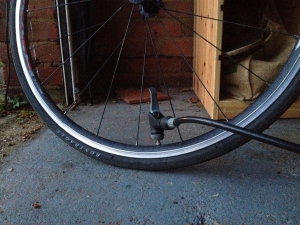Safety: Tire Integrity and Pressure
 There are two major considerations regarding tires and safety. The first is short-term tire integrity. A blowout, especially a front wheel blowout, can cause broken bones and broken bikes. The second is long-term comfort and efficiency. A comfortable and efficient rider goes a long way toward being a safe rider.
There are two major considerations regarding tires and safety. The first is short-term tire integrity. A blowout, especially a front wheel blowout, can cause broken bones and broken bikes. The second is long-term comfort and efficiency. A comfortable and efficient rider goes a long way toward being a safe rider.
Regarding blowouts, here are a few important considerations:
Don’t put a compromised tube or a compromised tire on the front wheel. A patched tube or a tire with a cut significant enough to require a boot is more apt to blow than an undamaged tube or tire. Further, the compromised portion of the tire or tube is most likely to blow out when it is under the most stress. For example, when executing a hairpin turn on a fast downhill. You don’t want to crash under any circumstances, but you certainly don’t want to crash while turning, especially while under the influence of gravity.
So, if you must patch or boot a front tube or tire on the road, take it easy for the rest of the ride. Put a fresh tube and a sound tire on the wheel before your next ride. If your rear tire and tube are in good shape, consider swapping them out for the front tire and tube for the remainder of your ride, especially if the remainder of your ride will involve the kind of stress that could make a weak tire blow. Rear blowouts are bad, but not quite as bad as front blowouts.
Regarding tire pressure, think 15% drop.
Frank Berto, a professional engineer-cyclist and frequent contributor to Bicycling magazine back in the day, wrote the seminal article on tire pressure back in the 1980s. He conducted his own tests and consulted with the engineers at several tire companies, including Michelin and Continental.
The consensus was that a 15% drop – the drop is the amount your tire is squished when you are on the bike – provides the best combination of comfort and efficiency. Too much pressure and it feels like you are riding on a jackhammer. You might feel you are going fast but every little irregularity in the road surface is making your tire bounce, reducing contact with the road as well as transmitting all those minor jolts to you, the rider. You are actually slower and less comfortable than you would be with lower tire pressure. Too little pressure and it feels like you are pedaling in sand, and you are more subject to pinch flats.
Somewhere between those two extremes – at a pressure that will give about a 15% drop – you get the optimum balance of low-rolling resistance and a comfortable ride which also minimizes flats.
Berto recommended that you take into consideration the weight on each wheel. For road riders in an average touring position, about 45% of the total bike and rider weight is on the front wheel and about 55% on the back wheel. (Of course, if you are loaded touring, consider the weight you have added to each wheel.) See links below to a few relevant articles, including one by Berto himself which includes the chart he developed. You may want to download or bookmark the chart so you will have it handy for reference.
In the meantime, here is an example of what the chart suggests. Consider a couple with identical 25-pound bikes, where one rider weighs 175 pounds and the other weighs 125 pounds.
- For the heavier rider, on 25 mm tires, ideally the rear tire would be at about 100 psi and the front tire about 80 psi. For 28mm tires, the rear would be a little over 80 psi and the front a little under 70 psi for the heavier rider.
- For the lighter rider, with 25 mm tires, the rear would be a little over 70 psi and the front tire a little under 60 psi. For 28 mm tires, the rear would be a little under 60 psi and the front a little under 50 psi for the lighter rider.
Quite a difference. Now for the promised links:
- Click here for a version of Berto’s original article.
- Click here for a link to an article with Berto’s chart on a per wheel basis.
- Click here for a link to a more recent article discussing the effects of tire suppleness on optimum pressure.
- And for those of you who don’t like charts, click here for a link to a PSI calculator, based on Berto’s charts.
(The calculator yields slightly higher results than the charts, but both are in the same ballpark.)
Steve Price, Member at Large
